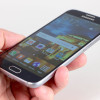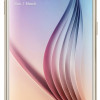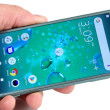Review: Samsung Galaxy S6 for Sprint
Screen
The S6 sports a 5.1-inch quad HD screen. The display relies on Samsung's OLED technology and it's very bright. Colors are perhaps not quite as accurate as I'd like, but that's only because Samsung likes to boost them to appear more intense. The size and resolution are a match made in heaven. The pixel density is incredible; everything on the screen is razor sharp. I found the display quite easy to read outdoors, even under sunny skies. You can't ask for a much nicer display in a modern smartphone.
Signal
Like the S6 Edge, the S6 performed a bit above par when compared to other devices I've tested on Sprint's network in and around New York City. It was faster to connect to LTE when available, and held onto Sprint's LTE network longer. I was easily able to make calls even under the worst signal conditions, and data pushed through at times when the phone showed no signal at all. Call handoffs to cell towers when traveling on the highway were smooth, and the phone never dropped a conversation. The S6 is the first Spark phone from Sprint I've reviewed that's exhibited a real speed boost when Spark is available. Data speeds over Sprint Spark were fairly quick.
Sound
The S6's performance characteristics are identical to those of the S6 Edge. I was very impressed with call quality. Calls I placed through the S6 were loud and clear, just how I like them. The earpiece delivered excellent clarity and enough punch to overcome noisy spaces, such as coffee shops during the morning rush and restaurants during a busy lunch hour. Voices sounded clean, warm, and present. Those I spoke to through the S6 said I sounded really good. I was equally impressed with calls when I used the speakerphone. The speaker offered distortion-free conversations that were loud enough for the car and other spaces, such as home or the office. Ringers and alerts will certainly get your attention without trouble, even if the phone is on the other side of the house. The vibrate alert is strong enough for you to feel it in a coat pocket, backpack, or purse. When the phone is flat on a table, the vibrate alert will send it sliding sideways.
Battery
The S6 has a 2,550 mAh battery sealed inside the chassis, which is a step down from the 2,800 power cell inside last year's Galaxy S5 and just slightly smaller than the Edge's 2,600 mAh battery. In my heavy-usage tests, the S6 was begging for mercy after 16 hours of active time. With less-intense use I saw closer to 18 or 19 hours of uptime. The phone has a power-hungry processor and display, but does provide about one more hour of battery life compared to the Edge despite the smaller battery.
Samsung included its Power Saver and Ultra Power Saver modes. These do make a difference if you run into trouble. The first option tones down a few features and doesn't crimp the phone's performance too much. For example, it will limit the CPU a bit, turn down brightness, turn off the key backlights, and put the display to sleep faster. The second takes a more aggressive approach and kills off all but the basics. It strips the UI down to the bare essentials, goes grey-scale, and prioritizes only key functions, such as calling and messaging. These will help you save power.
I tested the S6 on two different wireless charging pads I have. It worked with both. It charged slowly, but it had no problem switching between the two different standards used by the pads. The phone is very quick to charge when plugged into the supplied charger.


 Review: Samsung Galaxy S6 for AT&T
Review: Samsung Galaxy S6 for AT&T
 Review: Samsung Galaxy S6 for Verizon Wireless
Review: Samsung Galaxy S6 for Verizon Wireless
 Hands-On: Samsung Galaxy S6 and Galaxy S6 Edge
Hands-On: Samsung Galaxy S6 and Galaxy S6 Edge
 Liveblog of Samsung's Galaxy S6 Launch
Liveblog of Samsung's Galaxy S6 Launch
 Samsung's Galaxy S6 and S6 Edge Tout Metal and Glass Designs
Samsung's Galaxy S6 and S6 Edge Tout Metal and Glass Designs
 Samsung Galaxy S6 (GSM)
Samsung Galaxy S6 (GSM)
 Samsung Galaxy S6 (CDMA)
Samsung Galaxy S6 (CDMA)






